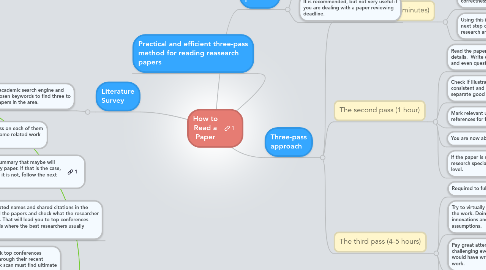
1. Gather these papers and the ones from first step and you have the first draft of your survey. Make two passes through them. If all of them cite one paper, make sure you read it, and add it, if it is necessary.
2. The third step: Check top conferences websites and look through their recent proceedings. A quick scan must find ultimate qualified work
3. Second step: Find repeated names and shared citations in the bibliography. Download the papers and check what the researcher have published recently. That will lead you to top conferences websites, because that is where the best researchers usually publish.
4. You will find a summary that maybe will point to a survey paper. If that is the case, you are done. If it is not, follow the next step.
5. Do the first pass on each of them and look for some related work sections.
6. Practical and efficient three-pass method for reading reasearch papers
7. Literature Survey
7.1. First, use an academic search engine and some well-chosen keywords to find three to five recent papers in the area.
8. Three-pass approach
8.1. The first pass (5-10 minutes)
8.1.1. Quick scan to get a bird's-eye view of the paper. Search for: categority, context, correctness, contributions and clarity.
8.1.2. Using this information, consider following the next step or not. If the paper is not in your research area, the first step may be enough.
8.2. The second pass (1 hour)
8.2.1. Read the paper with grater care, but ignore details. Write down notes on points to review and even questions to the author.
8.2.2. Check if illustrations, graphs mainly, are consistent and proper.This will help you separate good from bad work.
8.2.3. Mark relevant unread references for further reading.
8.2.4. You are now able to summarize it.
8.2.5. If the paper is not on your research speciality, stop at this level.
8.3. The third pass (4-5 hours)
8.3.1. Required to fully understand a paper.
8.3.2. Try to virtually re-implement the paper: re-create the work. Doing this, you will identify both innovations and failings in the paper's assumptions.
8.3.3. Pay great attention to detail, identifying and challenging every assumption. Think of how you would have written it and note down ideas for future work.
8.3.4. You are now able to reconstruct the entire structure of the paper from memory, as well as able to identify its strong and weak points.
